
By helping to improve drilling accuracy, Minnovare CORE analytics reduce rework and
increase productivity. (Photo: Minnovare)
A Tale of Three Suppliers
The demand for proven solutions for reducing dilution is growing. Recent developments
for three innovative suppliers show the growth curve to being able to meet that demand
and profit from it.
By Jesse Morton, Technical Writer

Three suppliers of the most innovative solutions for reducing dilution in narrow vein mining are at three different milestones in the journey to market acceptance. One is an established, successful supplier, recently acquired by a top-tier mining technology company. It is currently developing its suite of proven solutions and integrating them with those of the new parent company. Another was just awarded funds to field-prove a new system that employs a solution that only recently hit the market. The third is engaged in a series of trials to generate data on its solution and process that has previously earned much interest but failed to fully blossom. For all three, the future seems bright so long as they can continue to prove the viability of their solutions.
Improving Drilling Outcomes
Hexagon Mining division company Minnovare
announced the global release of
the Development Optimizer, a hardware
and analytics package that can be used
to optimize drill alignment, accuracy and
speed for improved drilling outcomes.
Leadership at the supplier said the platform
delivers significant value for underground
mines.
“With the release of the Development
Optimizer, Minnovare now offers a comprehensive
range of industry-leading
drilling optimization solutions that spans
from exploration and resource definition
through to mine development and production,”
said Callum McCracken, managing
director, Minnovare. The range also includes
the Azimuth Aligner, the Production
Optimizer, and Minnovare CORE.
“Another exciting development is the
work we have been doing with our clients
focused on the ESG space,” he said.
“Working with a number of our customers
we have been able to calculate some
significant reductions in an underground
mine’s CO2 emissions driven by improvements
our technology delivered across
production and development drilling.”
In underground narrow vein operations, Minnovare solutions help improve drilling accuracy, which reduces the volume of waste material to handle and process. Handling and processing waste generates “no additional revenue and resulting in an unnecessary increase in CO2,” McCracken said. “We have seen that the benefits delivered to a typical underground narrow vein mine is in excess of a 3,000-metric ton (mt) reduction in CO2 annually,” he said. “To put that saving in perspective, that’s approximately the same benefit annually as converting 1,000 light vehicles to electric vehicles!”
Entering partnerships and adopting solutions that help reduce emissions is “quite compelling” to investors. “In addition to investors’ expectations around an operation or a company’s environmental and more broadly ESG impact, we have proven that mines that implement our technology in resources definition, production or development can materially improve the efficiency, productivity and profitability of their operations, making the company more attractive when benchmarked against its peers,” McCracken said. “For the mine, we deliver tangible benefits with proven, reliable technology, provide the training and ongoing support, and oversee the change management process.”
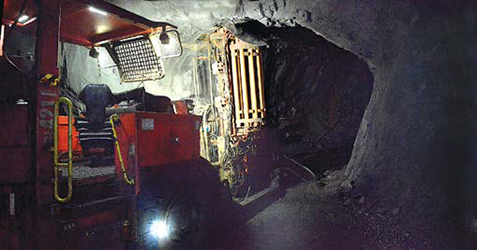
Case studies also show that Minnovare solutions can help a miner stay true to drill plans. “Historically mine plans were developed electronically, then printed in hard copy, with any changes or updates resulting in a new paper plan being printed off,” McCracken said. “With our products we digitize this process to ensure data fidelity and what is designed is what gets drilled.” Minnovare CORE offers analytics and reporting capabilities that “provide engineers, geologists and planners insights in near real time, while giving drill operators an electronic record of the quality to which they completed their tasks,” he said. “Additionally, accurate drilling results in less rework, which helps an operation maintain their cycle time and execute per their plan.”
Less rework translates to improved drill rig productivity, “which in many cases also flows through to an overall reduction in stope cycle time, meaning more stope cycles can be completed using the same number of personnel and equipment, resulting in an increase in the overall output of the mine,” McCracken said. The net increase in production at a cost that is unchanged reduces the average cost/ mt of material produced. The same case studies show Minnovare solutions can help improve safety, something “that we are extremely excited about,” McCracken said. “Each of our solutions deliver safety benefits; however, as part of Hexagon’s newly formed underground business unit, we will bring a range of industry-leading safety solutions to existing and new customers operating globally.”
Hexagon Mining’s One Partner strategy seeks to combine capabilities and benefits from multiple solutions on one platform. “Hexagons Operator Awareness and Collision Avoidance solutions have been deployed at mine sites globally and are now available and tailored for use in underground,” he said. Minnovare solutions can help customers that are short on staff and parts inventory. “Firstly, our technology enables operations to achieve consistent drilling outcomes regardless of the experience or skill of their operators,” McCracken said. “In a time in the industry where turnover is high, this becomes increasingly valuable for our clients, with new less-experienced operators needing to be trained and put onto drill rigs to ensure operational continuity,” he said. “Secondly, we do a lot of the heavy lifting with respect to onsite training and change management.” The two capabilities “have become increasingly valuable with the high rates of turnover and labor shortages experienced over the last few years.”
By improving drill rig and rig operator performance, Minnovare solutions help reduce a customer’s need to replace equipment and parts. “Minnovare adds value by extending the life of an operation’s existing drill rig,” McCracken said. “And secondly, we replace a large number of sensors commonly found on a drill rig with a single sensor platform, meaning there is a lot less to go wrong,” he said. “Our service and support team remotely monitors the health of our equipment on site daily, enabling us to alert a customer and replace a piece of equipment pro-actively if required, minimizing downtime commonly associated with equipment breakage.”
Putting data to work to enable autonomous, connected ecosystems that boost efficiency, productivity and quality is one of Hexagon Mining’s core missions. “Minnovare’s mission is to maximize the profitability and productivity of underground hard rock mining globally by providing our customers with industry-leading, user- centric drilling technology, data and analytics,” McCracken said. “Both mission statements clearly outline the group’s focus on delivering our clients value through technology and automation, and delivering safer, more productive and more profitable underground mines.”
Winning Funding
for Innovation
In June, Novamera reported it won funding
from Canada’s Mining Innovation
Commercialization Accelerator (MICA)
to demonstrate and further develop its
surgical mining system. The company
was one of two dozen awarded for innovation
at increasing productivity, cutting
energy consumption, implementing autonomous
solutions, and reducing environmental
risk.
Novamera said the selection process
was highly competitive. “We’re thrilled
to have succeeded,” said Allan Cramm,
vice president of innovation.
“Novamera’s surgical mining technologies radically increase orebody visibility in real-time and provide new opportunities for miners to quickly add to production with existing narrow vein deposits that often sit on the periphery of existing operations,” he said. “This would allow mining companies to add to their production quickly and sustainably, with minimal CAPEX costs.” The MICA funding will go to demonstrating the full suite of Surgical Mining Technologies with a producer located in Newfoundland. “This will demonstrate the entire cycle from orebody mapping using the proprietary Guidance Tool for surgical extraction of ore using the Smart Drilling System,” Cramm said. “The project aims to showcase the opportunity for mining companies to unlock narrow vein deposits that would otherwise be left unmined due to their complex size and geometry.”
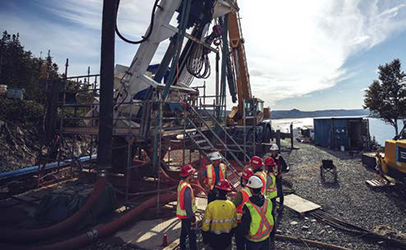
The tool integrates into a standard NQ-size diamond drill. “During drilling the tool is deployed via wire line and scans a 3-m radius around the borehole to identify changes in lithology between the host rock and mineralized zone, in real-time,” he said. “The data is then used to build a 3D orebody model and calculate the optimal trajectory for extraction using the Smart Drilling System.” The system works with a conventional pile-top drill rig (PTDR) “to extract the ore, following the trajectory prescribed by the Guidance Tool,” Cramm said. The cutting head is sized for the application.
“The PTDR, for surface applications, uses reverse circulation with airlift assist to transport the cuttings to surface,” he said. The cuttings go to a material separation system for dewatering and processing. “The two-stage cycle continues along the strike of the vein, with each primary hole backfilled during the process with a mix of tailings and cement to stabilize the ground.”
Beyond minimizing dilution, the list of benefits includes improved efficiency, reduced development time, and improved productivity. “The entire Surgical Mining Suite can allow miners to add to production quickly and sustainably with relatively low CAPEX using periphery narrow vein deposits,” Cramm said. “As the technology works together with conventional equipment, it can be deployed quickly and with minimal disruption to leverage existing infrastructure and permitting.” With no blasting, the system is relatively safer than competing solutions and is well suited for deposits near residential areas or that are highly regulated.
With cofounder Dustin Angelo, Cramm began developing the system in 2019 at Anaconda Mining in Newfoundland. “We had tremendous support from Memorial University researchers led by Dr. Steven Butt and the College of The North Atlantic throughout the early development,” he said. The first proof of concept was announced in 2021. Commercial field demonstration of the Guidance Tool was completed in 2022.
Currently, the company “is continuing to build momentum securing several awards and strategic alliances including WSP, CMIC and Sumitomo to boost awareness and reach across the sector,” Cramm said. “The technology is now being brought to market with early customers,” he said. The Guidance Tool is currently available. “If a company is interested in determining if surgical mining is a good fit to add more production to its project, Novamera offers economic evaluations and field demonstrations to trial the entire suite of Surgical Mining Technologies onsite and facilitate a fast and simple engagement process.”
Proving Spalling Works
G.E.T.T. Gold said it will seek to partner
with a miner to further trial and develop
its thermal fragmentation technology and
method for narrow vein mining after multiple
testing projects wrap up this summer.
It is talking to companies in Canada
and elsewhere that went bankrupt due to
losses driven by dilution.
“Currently, we are also targeting companies in Ireland, England, and in New Zealand,” said CEO Fabien Miller. “In all of these countries, the regulations are really restrictive, and we need to be able to conform to the restrictions before we present our technology,” he said. “This is exactly what the current testing can prove.”
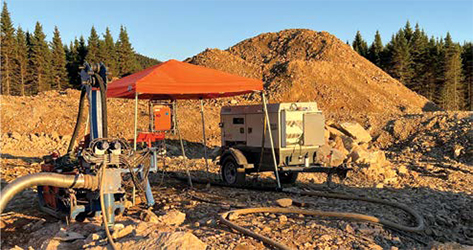
With the Spalling Assist Mining Method, a hole is drilled into the vein using a top hammer or a down-the-hole drill rig. Thermal fragmentation technology originally developed in Russia and first marketed by Nippon Dragon energizes the vein with a heat shock wave, spalling the vein. The heat can shatter the width of the vein. Roughly a third of the vein fragments can be recovered during the process. Afterwards, low-energy stope-limited slashing recovers the rest. The “result is a narrow stope that follows vein geometry,” company literature said. From a 15-cm drill hole, an up-to- 60-cm primary opening is created between secondary blastholes.
According to G.E.T.T. Gold, last fall, on a 0.5-m-wide vein, the technology and method were simulated and compared head-to-head with a conventional drill-and-blast program using long-hole stoping in a zipper pattern. “The spalling- assisted narrow stope resulted in about 450 mt, versus 1,300 mt for the long-hole stope,” the company reported. Dilution for the long-hole stope “can be up to 196%,” while there was “virtually no dilution for the spalling-assisted stope.” The costs for the long-hole stope were 20% higher. “The fragmentation spalling assisted method was approximately 10% quicker,” the company said.
The case study adds to the evidence that the technology and method can reduce dilution by at least 30%, Miller said. “Meaning that less material needs to be transported, treated, and disposed. Add to that the costs savings of using less assets and fuel,” he said. “We are really confident it will do that.”
To instill that confidence in potential clients, the company has been subjecting the technology and method to multiple tests for more than a year. One test is to determine the types of rock on which thermal technology is the most effective. Other tests assess the capabilities of upgrades implemented to the thermal unit and determine the emissions of the technology and method.
Previous tests demonstrated that the technology and method was very effective on rhyolite and quartz. This summer, additional surface tests will be conducted at Montauban les Mines. Using an “optimized thermal unit, we conducted tests on surface where we characterized the volume or the diameter of the hole and were able to fragment continuously for a certain period of time,” Miller said. “Right now, we are working on a type of graph that will identify the spall-ability index for various types of rocks and will attribute a factor or value for each type of rock.”
The unit involved was optimized after Technical Director Mark Van Schaik upgraded it to improve performance. “The upgrades and improvements to the lance were implemented last year as an R&D project,” Miller said. An upcoming program involves gas emissions monitoring. “The heat from the lance has the potential to cause sulphur emissions from within the rock,” Miller said. “We are measuring the gas emissions in order to know in advance what kind of gas will probably be generated underground and how we can scrub them to meet underground gas TLV constraints.”
The company is also testing a new controller that “allows us to better control the mixture of air and diesel,” he said. “We need to qualify our burning ratio or conversion.” A third party is overseeing the measurement of emissions. “With the new regulations worldwide, you cannot go underground with equipment without any information about your conversion, what kind of gas emissions you will generate,” he said. The company is also trialing technology that captures the gas emissions.
Results from the testing could be made public as early as the end of August. So far, the results have been promising, Miller said. “We are starting to have a much better understanding as to why some rock types were not fragmenting well,” he said. “Our understanding of the process is now deeper.”
The laboratory testing has shown that the technology and method might work well in some applications in lithium mining. “We are developing our market not only for underground operations but also for surface deposits and are very pleased with the preliminary tests with the technology on an orebody containing lithium material for the fabulous EV market that everybody is going after,” Miller said. “This is one of the targets that we have in mind,” he said. “And we are talking to various lithium companies where we want to do surface trials.”
Most importantly, the testing is generating data on the technology and method. The results will aid in future improvements and in proving viability. Miller said the results will hopefully distance G.E.T.T. Gold and its practices from its predecessor, Nippon Dragon, which announced the solution before proving it. “The reason why we changed the name of the company is to create a space between the history and what we are doing right now.” Nippon Dragon lacked the expertise and the discipline that G.E.T.T. Gold now has, he said. “We are a completely different operation and operators right now,” Miller said. “Our approach is a lot more measurable, a lot more precise, a lot more accurate, and when we say we are doing this it is because we have a proven record showing that, which was not necessarily the case before.”
CSR-driven Aramine Launches Battery-powered Loader With Longer Range
Aramine recently launched the L140B V2, which is powered by
a new battery pack. The pack uses a lithium-iron-phosphate
battery that is “now the prismatic battery type,” said Audrey
Beurnier, marketing and communication manager.
“This has allowed our machine to gain 57% autonomy, from 3.5 hours to 5.5 hours, and to reduce by 20% the charging time, from 4 hours and 20 minutes to 3.5 hours,” she said. “In other words, the energy in each energy module is going from 24 kWh to 42 kWh with the same volume and weight.” The added autonomy and uptime will improve the performance of the unit. “The good news for all our customers already using our L140B is that the machine’s operating software system just needs to be updated to use the new module energy,” Beurnier said. “The update will be free of charge for any purchase of the new battery-powered energy module,” she said. “Our new operating software allows our end-users to use the new battery modules but also the original one alternatively as they are totally interchangeable.”
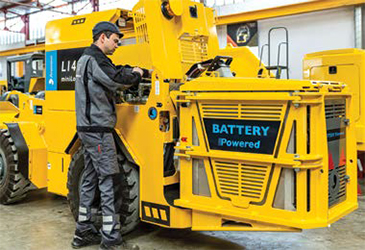
“For each point we come up with actual actions to have a positive impact on the world,” Hebert said. “For example, battery- powered machines developed for lower CO2 emissions, narrow vein mining machines, and planting 1,450 trees in Madagascar since 2019.”
Other examples include employee promotions and career monitoring, “technical training and skills transfer, and employee share ownership,” she said. To accomplish societal responsibility goals, Aramine has been “a member of the United Nations Global Compact since 2017, is building a school cafeteria in Nepal, is renovating a school in Mexico, and donates to associations in the cultural, education and health sectors.”
The history of the company shows that CSR is in its DNA, Beurnier said. For example, Aramine launched a standard exchange program for customers in the 1970s. “Our principal argument was to avoid throwing away a component that can have a second or even a third life at a lower cost than a brand new one to produce.” In the 1980s and 1990s, the company developed its remanufacturing program, which scaled up the exchange program. More recently the company has developed “a new generation of underground machines for narrow vein mines, to allow operator’s to safely extract the raw materials” with precision, using less resources, Beurnier said. “Our battery-powered machines are in constant evolution, with new innovations to reduce our impact on the environment and protect the users.”
Customizable Komatsu LHD Offers ‘Outstanding Breakout Power,’ Options
Komatsu reported its newest LHD for narrow vein applications,
the WX03, is a 3-metric ton (mt) diesel machine that features
a rugged structure and an efficient powertrain and hydraulic
system. The unit has a 74-kW water-cooled engine, gives
“outstanding breakout power,” and uses parts common to other
loaders and trucks.
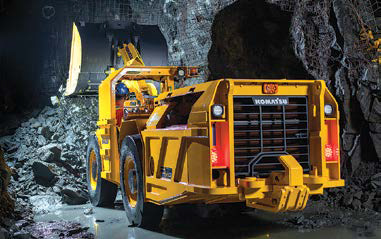
The unit comes equipped with technology that simplifies tasks. “Common software across most Komatsu models makes it easier for operators or technicians,” Vien said. “This is especially helpful when troubleshooting or diagnosing potential issues because most machines have the same control system.”
Replacing the popular LT-270, the WX03 can be customized to meet the needs of customers. “Some of the available options on the WX03 include an automatic lubrication system, ejector bucket, fire suppression system, quick-attach coupling system, radio remote control, and recovery hook,” Komatsu said. Depending on the application, engine options are available.